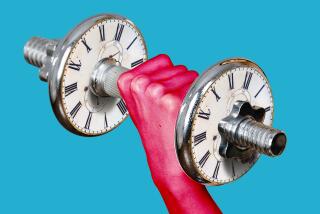A lube job for the weekend warrior
- Share via
You’ve heard it for years, from your PE teacher of yore to your personal trainer of today: Warm up before you start strenuous exercise.
“Absolutely,” you mutter, confident that this advice applies to other people, like those who are not as busy as you, or who are in even worse shape.
Well, the older you get, the more important it is to warm up before you shift your body into second gear and beyond.
Warming up properly can spare you from injury that could put you back in front of the TV for several weeks or more.
By warming up, “you are essentially giving yourself a lube job,” said Cedric X. Bryant, chief exercise physiologist for the American Council on Exercise.
By gradually boosting your body temperature, you increase the elasticity of muscle and connective tissues, including ligaments, tendons and cartilage.
Challenging cold muscles and other tissues too quickly with strenuous exercise could result in pulls, strains and sprains.
And starting an exercise session with gentle movements activates the fluids in your joints, thereby reducing friction -- and cutting down wear -- in those ever-important hinges.
Warming up also gives your cardiovascular system time to push blood into your extremities, bringing oxygen and other vital nourishment to your muscles. Plus, it helps your heart adjust before the more strenuous workout begins, said Bryant.
If you jolt from a resting state into high-intensity exercise, your heart will demand oxygen more quickly than the rest of your cardio system can deliver it.
“In certain susceptible populations,” including people with cardiac arrhythmia, “this could increase the risk of a heart attack” during exercise, Bryant cautions.
Warming up becomes more important roughly from the mid-40s onward because, over time, our tissues become less supple and our synovial fluid levels drop.
“The lack of sufficient warm-up contributes to lots of weekend-warrior injuries,” Bryant said, especially in middle-aged exercisers.
Start with controlled, gentle movements of the muscles and joints you plan to use during your workout and gradually increase the intensity. If you’re going cycling, get on a bike and pedal slowly for a bit.
For jogging, start out walking and work smoothly up to your rhythm. For walking, simply start below your target pace and increase the speed steadily. Ditto for tennis, roller-skating, soccer and other sports.
Before a strength-training workout, do some light calisthenics in addition to a walk or jog.
(Important note: Contrary to what you may have heard, stretching is not the same as warming up. In fact, stretching cold muscles can do you more harm than good. To avoid tearing muscle, it’s better to delay stretching until the tissue is a bit warm.)
Warm up until you start to perspire, Bryant suggests; sweating indicates that you have raised your body temperature by two degrees, enough to lubricate joints and make your tissues more pliable.
For most people this should take five to 10 minutes, slightly longer as you creep past age 50.
